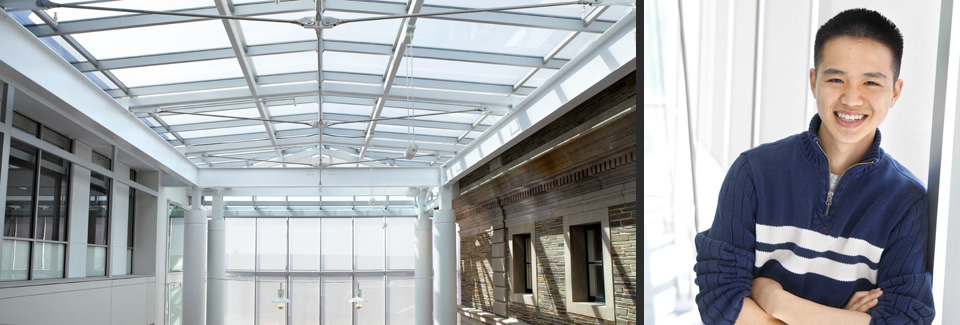
Class of 2012
As Daniel Lu ’12 sees it, his four years as a Cornell undergraduate were defined by one question: “What have I made?”
The summer after his freshman year, Lu came across the website of electrical engineering major Jeremy Blum ’12 and watched a video about Blum’s robotics programming class project, an automatic-tracking NERF sentry gun.
“I just thought, ‘wow!’” recalls Lu, a civil engineering major from Potomac, Maryland. “It prompted me to ask myself, ‘What have I made, and what have I done, especially since I’m an engineer? What, really, have I made?’”
Although as a freshman Lu had been a member of the Cornell Solar Decathlon team that placed fifth in a national competition, he wanted to play an important role in a project from design through construction.
The Solar Decathlon project evolved into Cornell University Sustainable Design, a group that orchestrated two interdisciplinary, research-based efforts—the Sustainable Research Facility Project and Schoolhouse South Africa—bringing students and faculty together to design and build structures using sustainable materials and practices. Lu became involved with both projects but says Schoolhouse South Africa was his best experience at Cornell. The project included 60 Cornell architecture students who worked with five professors to design an early childhood development center in Cosmo City, a community north of Johannesburg, South Africa.
“I felt that it was an ambitious … an interesting project, and I felt that it helped me explore what buildings can do for people and for humanitarian purposes,” says Lu, who led a building-system design team for the project.
“I kept checking the website, and I kept seeing this building slowly getting built,” Lu says. “That was just an immediate, fascinating, and incredible feeling I got because I’d helped with the structural engineering of the school.”
It was an experience that helped Lu understand how much he was attracted to sustainable engineering.
As a civil engineering major with a minor in architecture, Lu says the Schoolhouse South Africa project also pulled him out of his comfort zone. “I’m a civil engineer, but I wasn’t too interested in building materials at the time. I really wanted to explore the community aspect of building.”
The experience of designing a building that uses sunlight for heating and cooling prompted Lu to also think more about sustainability aspects of a building’s energy performance. As a result, when he began to apply to graduate schools, Lu tried to find ways that building heating and lighting could fit into a master’s degree program in structural engineering.
“Last fall, when I began to apply to graduate schools, I was mainly focused on pursuing a master’s in structural engineering,” he explains. “There were some aspects where a structural engineer can be sustainable, but those aspects did not interest me as much as the lighting and heating of the building. That’s what I felt was a huge contribution to a building’s energy performance: how it controlled its lighting and its heating. More and more I felt like if I’m just doing structural engineering, how do I fit in with that?”
For Lu, who has been accepted into the graduate structural engineering programs at the University of Texas at Austin and Purdue University, the answer lies in facades design, the design of building exteriors.
“You have architects controlling how the building looks on the outside, how it’s detailed. You have lighting consultants who control how much daylight comes into the building, and of course, how well the exterior insulates the interior of the building is a very important aspect,” says Lu. “That’s what I want to focus my graduate studies on after May. The two schools that admitted me do have professors and resources in that area, so I feel like that’s what I want to look into a bit more.”
As president of the Phoenix Society this year, Lu led a team of engineering students in building the College of Engineering’s annual contribution to Dragon Day. It was an experience that taught him the difference between leadership and managing. “Some of my friends who were on my [executive board] would say I’m not the best leader, but I’m fairly good at managing,” he says.
“Leadership is about inspiring people, and sad to say, I wasn’t that good at it. Management-wise, it’s about having the right expectations of who you are working with,” he says. “I was so focused on moving the project forward, I forgot about what I really should expect out of people. The overall lesson from all of this was that oftentimes projects seem to be screaming in your face to get done, but you really should focus more on the relationships with the other people you are working with.”
He was one of three recipients of the 2012–2013 Thornton Tomasetti National Scholarship—a scholarship that provides $10,000 for expenses related to pursuing a master's degree in structural engineering—but he is still undecided about graduate school. Instead, he will begin an internship in the New York City office of an engineering consulting firm, Buro Happold.
“Five years from now, I want to be working with buildings,” Lu says. “Structural engineering is still fairly interesting so I really want to see a project through in that area, but more and more I want to be a facades engineer and be involved in the design of the building envelope.”





